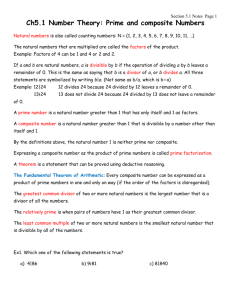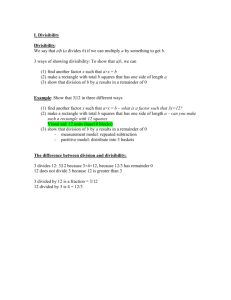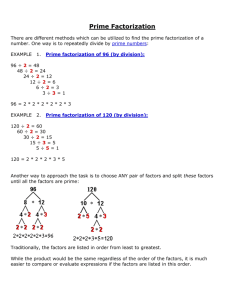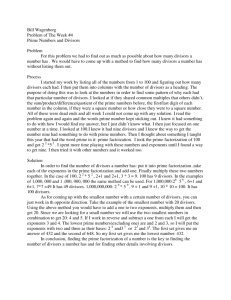Math 365 Lecture Notes – J
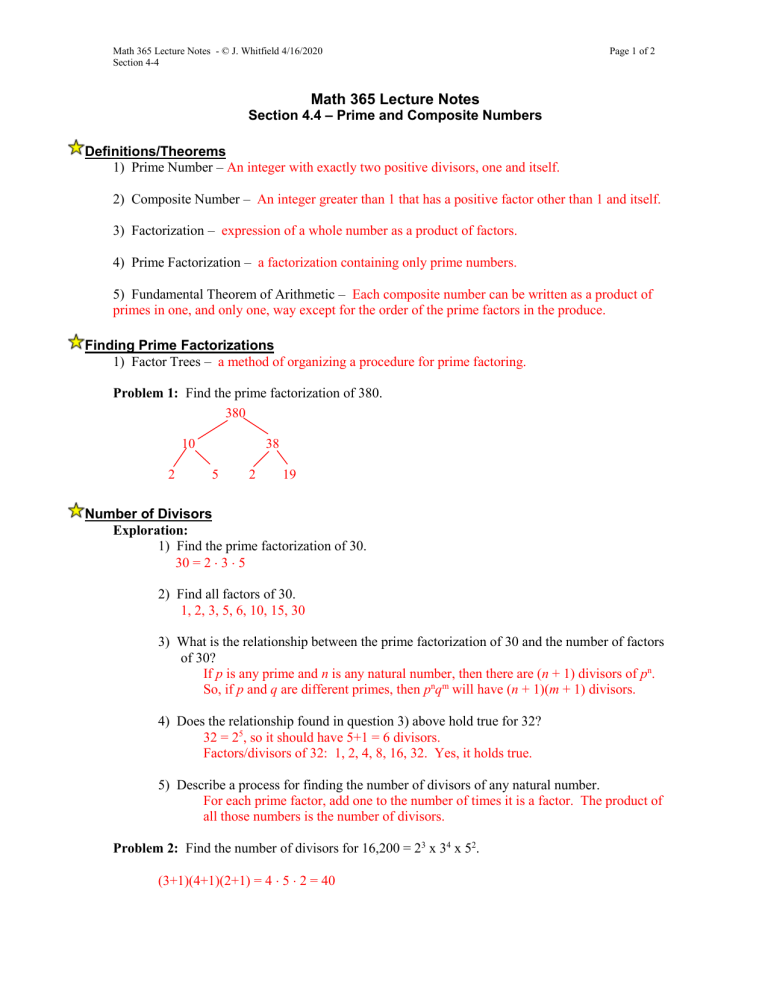
Math 365 Lecture Notes - © J. Whitfield 4/16/2020
Section 4-4
Page 1 of 2
Math 365 Lecture Notes
Section 4.4 – Prime and Composite Numbers
Definitions/Theorems
1) Prime Number – An integer with exactly two positive divisors, one and itself.
2) Composite Number – An integer greater than 1 that has a positive factor other than 1 and itself.
3) Factorization – expression of a whole number as a product of factors.
4) Prime Factorization – a factorization containing only prime numbers.
5) Fundamental Theorem of Arithmetic – Each composite number can be written as a product of primes in one, and only one, way except for the order of the prime factors in the produce.
Finding Prime Factorizations
1) Factor Trees – a method of organizing a procedure for prime factoring.
Problem 1: Find the prime factorization of 380.
380
10 38
2 5 2 19
Number of Divisors
Exploration:
1) Find the prime factorization of 30.
30 = 2
3
5
2) Find all factors of 30.
1, 2, 3, 5, 6, 10, 15, 30
3) What is the relationship between the prime factorization of 30 and the number of factors of 30?
If p is any prime and n is any natural number, then there are ( n + 1) divisors of p n .
So, if p and q are different primes, then p n q m will have ( n + 1)( m + 1) divisors.
4) Does the relationship found in question 3) above hold true for 32?
32 = 2 5 , so it should have 5+1 = 6 divisors.
Factors/divisors of 32: 1, 2, 4, 8, 16, 32. Yes, it holds true.
5) Describe a process for finding the number of divisors of any natural number.
For each prime factor, add one to the number of times it is a factor. The product of all those numbers is the number of divisors.
Problem 2: Find the number of divisors for 16,200 = 2 3 x 3 4 x 5 2 .
(3+1)(4+1)(2+1) = 4
5
2 = 40
Math 365 Lecture Notes - © J. Whitfield 4/16/2020
Section 4-4
Page 2 of 2
Determining Whether a Number is Prime
Theorems:
1) If d is a divisor of n , then n / d is also a divisor of n .
2) If n is composite, then n has a prime factor p such that p 2
n .
3) If n is an integer greater than 1 and not divisible by any prime p , such that p 2
n , then n is prime.
Problem 3: Explain the process to determine whether 247 is prime or composite.
Test for divisibility of primes through the largest primes less than the square root of 247.
Since 13 2 is 225 and 17 2 is 289, we will test through 13.
247 is not divisible by 2 since it is not even.
247 is not divisible by 3 since the digits add to 13, which is not divisible by 3.
247 is not divisible by 5 since the units digit is not 0 or 5.
247 is not divisible by 7 (short division process).
247 is not divisible by 11 (9 – 5 = 4 is not divisible by 11).
247 is not divisible by 13 (long division process).
247 must be prime.


